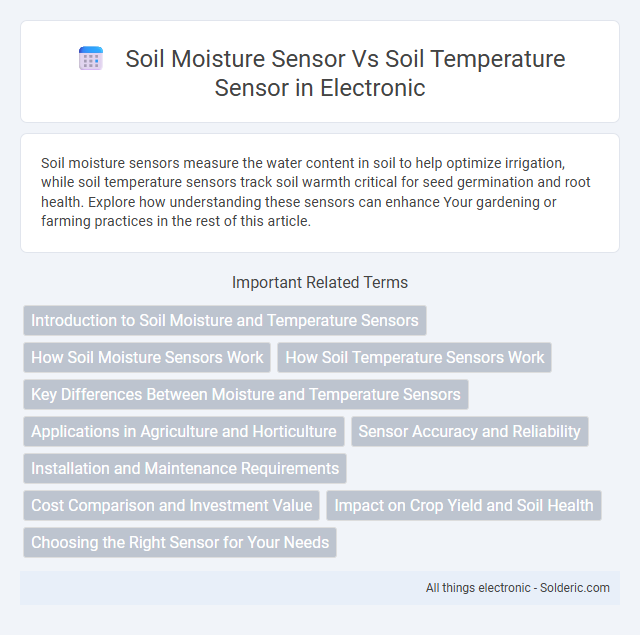Soil moisture sensors measure the water content in soil to help optimize irrigation, while soil temperature sensors track soil warmth critical for seed germination and root health. Explore how understanding these sensors can enhance Your gardening or farming practices in the rest of this article.
Comparison Table
| Feature | Soil Moisture Sensor | Soil Temperature Sensor |
|---|---|---|
| Purpose | Measures volumetric water content in soil | Measures temperature of soil |
| Key Metric | Soil moisture percentage (%) | Soil temperature in degC or degF |
| Applications | Irrigation management, drought monitoring, agriculture | Plant growth monitoring, frost detection, soil thermal studies |
| Sensor Types | Capacitive, resistive | Thermocouple, thermistor, RTD |
| Output Signal | Analog voltage or digital signal | Analog voltage, digital data, or frequency |
| Installation Depth | Root zone (6-12 inches typical) | Surface or root zone |
| Environmental Impact | Affected by soil salinity and texture | Stable measurement, less environmental interference |
| Cost | Moderate to high | Low to moderate |
Introduction to Soil Moisture and Temperature Sensors
Soil moisture sensors measure the volumetric water content in soil, providing critical data for irrigation management and plant health monitoring. Soil temperature sensors detect the thermal conditions of soil, influencing seed germination, microbial activity, and nutrient availability. Both sensor types play essential roles in precision agriculture by optimizing crop growth and resource use efficiency.
How Soil Moisture Sensors Work
Soil moisture sensors measure the volumetric water content in soil by detecting changes in electrical resistance or dielectric permittivity between sensor probes, which vary with moisture levels. These sensors typically use capacitance or time-domain reflectometry (TDR) methods to provide real-time data on soil hydration, critical for irrigation management. Unlike soil temperature sensors that track thermal variations using thermistors or thermocouples, moisture sensors specifically quantify water availability essential for plant health and optimized water usage.
How Soil Temperature Sensors Work
Soil temperature sensors measure the thermal energy of the soil by detecting heat transfer between the sensor and the surrounding soil, typically using thermistors or thermocouples. These sensors convert temperature variations into electrical signals, allowing precise monitoring of soil temperature dynamics critical for plant growth and microbial activity. Unlike soil moisture sensors that gauge water content, soil temperature sensors provide vital data on soil thermal conditions influencing seed germination and nutrient availability.
Key Differences Between Moisture and Temperature Sensors
Soil moisture sensors measure volumetric water content, providing crucial data for irrigation management by detecting water availability in soil. Soil temperature sensors track thermal conditions, influencing seed germination rates and microbial activity essential for plant growth. Moisture sensors use capacitance or resistive methods, while temperature sensors commonly employ thermistors or thermocouples, reflecting their distinct functional mechanisms and applications in agriculture.
Applications in Agriculture and Horticulture
Soil moisture sensors accurately measure water content, helping optimize irrigation schedules and prevent overwatering, which enhances crop yield and conserves water resources. Soil temperature sensors monitor root zone temperature, critical for seed germination, nutrient uptake, and pest management, ensuring healthy plant growth and timely planting. Your farm or garden benefits from integrating both sensors to maintain ideal soil conditions and boost productivity in agriculture and horticulture.
Sensor Accuracy and Reliability
Soil moisture sensors provide precise volumetric water content measurements critical for irrigation management, with accuracy often ranging between +-2-3%, while soil temperature sensors typically measure within +-0.1-0.5degC, offering reliable data essential for understanding root zone conditions. Both sensor types exhibit high reliability when properly calibrated and maintained, but moisture sensors can be more susceptible to soil salinity and texture changes affecting their readings. Advanced sensors with digital outputs and built-in temperature compensation enhance accuracy and long-term stability for both moisture and temperature monitoring.
Installation and Maintenance Requirements
Soil moisture sensors typically require burial at root zone depth to ensure accurate water content readings, with minimal maintenance involving periodic cleaning to prevent soil buildup on sensor surfaces. Soil temperature sensors need installation at consistent soil depths to capture reliable thermal data, often demanding careful calibration and occasional inspection to avoid damage from soil movement or moisture intrusion. Both sensors benefit from protective housing to extend sensor lifespan, though soil moisture sensors usually necessitate more frequent maintenance due to exposure to varying soil conditions.
Cost Comparison and Investment Value
Soil moisture sensors typically cost less than soil temperature sensors due to simpler technology and lower production expenses, making them a more budget-friendly option for basic irrigation management. However, investing in soil temperature sensors offers deeper insights into crop health and growth conditions, providing long-term value through improved yield predictions and pest control strategies. Evaluating the cost-benefit ratio depends on specific agricultural needs, with moisture sensors favored for immediate water efficiency and temperature sensors prized for comprehensive environmental monitoring.
Impact on Crop Yield and Soil Health
Soil moisture sensors provide critical data that helps optimize irrigation schedules, preventing both water stress and overwatering, which directly enhances crop yield and promotes healthier root development. Soil temperature sensors monitor thermal conditions essential for seed germination and microbial activity, influencing nutrient availability and overall soil health. Combining data from both sensors allows you to fine-tune growing conditions, maximizing productivity and sustaining long-term soil vitality.
Choosing the Right Sensor for Your Needs
Selecting the right sensor depends on whether monitoring water availability or thermal conditions is more critical for your agricultural or environmental project. Soil moisture sensors measure volumetric water content, essential for irrigation management and drought assessment, while soil temperature sensors track the thermal state, impacting seed germination and microbial activity. Understanding the specific impact of moisture versus temperature on your crop or ecosystem ensures optimal sensor choice for precision agriculture and resource efficiency.
soil moisture sensor vs soil temperature sensor Infographic

 solderic.com
solderic.com